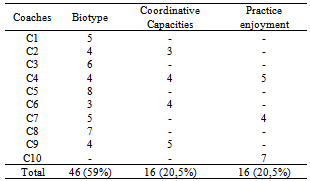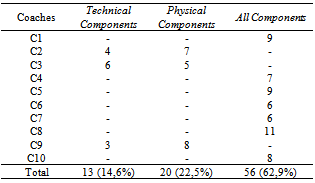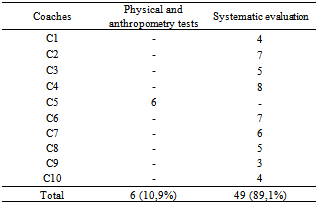-
Paper Information
- Next Paper
- Paper Submission
-
Journal Information
- About This Journal
- Editorial Board
- Current Issue
- Archive
- Author Guidelines
- Contact Us
International Journal of Sports Science
p-ISSN: 2169-8759 e-ISSN: 2169-8791
2013; 3(5): 157-162
doi:10.5923/j.sports.20130305.03
Coaches Representation about Detection and Selection of Talents on the Brazilian Volleyball
M. Milistetd1, I. Mesquita2, A. Souza Sobrinho3, P. Carrara4, J. Nascimento5
1University of Physical education, State University of Middle East, Irati, 84500-000, Brazil
2University of Sport, University of Porto, Porto, 4200-450, Portugal
3University of Physical Education, University of Campanha Region, Bagé, 4460-000, Brazil
4School of Physical Education and Sport, University of São Paulo, São Paulo, 05508-030, Brazil
5University of Physical Education, Federal University of Santa Catarina, Florianópolis, 88040-900, Brazil
Correspondence to: M. Milistetd, University of Physical education, State University of Middle East, Irati, 84500-000, Brazil.
| Email: |  |
Copyright © 2012 Scientific & Academic Publishing. All Rights Reserved.
The aim of this study was to analyse the representations of coaches about detection and selection of talent in Brazilian volleyball. Ten volleyball coaches working with junior categories were interviewed. A semi-structured interview was used and the comments were subsequently examined by content analysis. The encoding table used was based on Fernandes (2004). Concerning talent detection, coaches indicated as essential youth biotype, with height as the key indicator. In addition, they considered very important the technical resource and it is essential to enjoy the practice. For the young talent selection, it is important to evaluate the different components of training - technical and physical indicators. With regard to ways of talent detection, coaches cited the scholar competitions as a context for evaluation, but subjectively. In the young talent methods of selection, the process must be developed in a long term, when the more skilled develop their ability to optimize performance. It was observed that coaches employ empiric beliefs, maybe due to a lack of systematic education for volleyball coaches in Brazil.
Keywords: Coaching, Training, Trends, Volleyball
Cite this paper: M. Milistetd, I. Mesquita, A. Souza Sobrinho, P. Carrara, J. Nascimento, Coaches Representation about Detection and Selection of Talents on the Brazilian Volleyball, International Journal of Sports Science, Vol. 3 No. 5, 2013, pp. 157-162. doi: 10.5923/j.sports.20130305.03.
Article Outline
1. Introduction
- Nowadays is known that the training quality, the offering of practice opportunities and family support are essentials to talented children develop their potentials[1,2]. From that, the identification of young talented is an increasingly important aspect to researchers and coaches. Once discovered these individuals, resources can be provided to develop their potential; there is effort and time saving in trying to find them, as well reducing the harm caused to young people with less skills development[3,4,5,6,7].In sports, the term "talent" is considered to characterize individuals who demonstrate high biological and psychological capacities, which depending on the social background where they live, may present a high sport performance, from the appropriate environmental conditions [5,8,9,10,11].Much has been studied and still subject of study in an attempt to find indicators in children that may reveal their potential and predict their success[9]. Today, with technological advances, extensive research are carried out in this area, for example, gene identification aiming to distinguish individuals’ athletic performance[12].However, regardless of the methods or variables used, the detection of talents is understood as the process of finding individuals who show potential to acquire long-term capabilities required to perform the activity at the highest level of provision[6,7,13,14,15,16]. Thus, sports talent should be understood as a dynamic concept through the interaction of several factors. Detection of talents also must hold in a comprehensive multidimensional[8], taking into account biological, psychological and sociological, although there are no conclusions about the importance of each of them[13].It is assumed[14,17] that talent identification is more difficult in team sports than individual sports, as the large number of variables that can affect sports performance. Therefore, the search for an ideal profile of an athlete may not unusually be diagnosed in error, since it is known that besides the potential for some athletes to be revealed later, many athletes who have been prominent at lower levels do not have the same results in adulthood[6]. This way the identification or detection of talents must match the first step in a process of long-term training[4]. Researches describes a model wherein after the identification and detection of children and youth, an accomplished work of long-term is determined, and the end of each stage of training development is the process of "selection" of young athletes[7].In this context, the selection of sport talent refers to those individuals who have conditions to be accepted in the most demanding processes of long-term training, with the aim of achieving the highest sportive levels[4,5,6,7,14,18]. Nevertheless, it is discussed that the selection process of talent is an integral part of the athlete's long term training, in consequence, must be performed continuously during the different steps of sports[19].In volleyball, research conducted in Portugal and Brazil in recent years[6,11,14,20,21,22,23,24] have been indicating that the detection process, together with height, somatic and motor aspects assume greater importance than other indicators. The same experts[6,11,14,20,21,22,23,24] report that in addition to the anthropometric aspects, the coordinative constraints and technical, tactical, cognitive and psychosocial issues are the main indicators of the selection of talent.Although much has been already described, there is yet a great controversy among practitioners (coaches) and theoretical (researchers), in the detection and selection of sport talents[6]. It is common in the frame of reference procedures for detection and selection of sport, to verify the use of subjective procedures, in which the options of the practitioners are more determined by personal intuition, resulting from their experience in coaching, rather than by objective criteria properly defined[4,14].This strategy is seen as a risky option, because when a coach makes the choice by a player, he performs an act of selection; consequently, rejects other athletes, determining thereby the chances of success of young players[14].In Brazil there is no recommendation or formal reference, related to a long term players development, detection or selection of talents. Thus, this study aimed to identify the representations of Brazilian volleyball coaches, on the identification and selection of sport talents, particularly in identifying the criteria, means and methods that are important in the processes of detection and selection of volleyball talented.
2. Methods
2.1. Participants
- Ten coaches present in the junior male Brazilian Championship were part of this study. Seven coaches were state`s coaches, one was National team assistant and two were coaches of clubs in the states of Parana and Santa Catarina. The participants age and experience in volleyball coaching was respectively 45 ± 13.8 and 24.8 ± 12.1 years (mean ± standard deviation), all graduated in Physical Education. All coaches are in the stabilization phase (more than 5 years of experience)[25]. All participants read and signed informed consent documents for the study in accordance with the lead author’s Institutional Ethics Advisory Committee.
2.2. Instruments
- Data were collected using a protocol of semi-structured interview, focusing on coaches` views about procedures for the talent detection and selection in volleyball. All interviews were conducted by one author. The interview applied[22] intended to gather information on perceptions of sport coaches about volleyball players development in Portugal. Because the participants are Brazilian and therefore refer to a different sociocultural and sports reality, the interview content has undergone to some changes, validated by the method of expert valuation. The authority was the principal investigator and an specialist in the field of Volleyball, PhD in Sport Science with extensive knowledge in training and in player`s formation context, focusing performance. For the data collection some ethical and methodological assumptions were considered. The study purposes were explained to the coach and was tried to provide an enabling environment, emphasizing the interest in knowing coach`s proper perspective and genuine beliefs. The interviews took place during the team`s Brazilian championship, throughout the week, being held in a quiet place, intending to ensure the privacy and confidence for questions deepening. The coaches answered the following questions: What is the importance of height factor? How should be done the detection of talents? And the selection? Which is the more relevant indicators for each? Audio recordings were obtained from the interviews that were transcribed for analysis.
2.3. Data Analysis
- The coding grid was built from research[22] and the "corpus" of the interviews. The structure validation was supported by the literature[3,4,5,6,7,9,10,11,14,18] and content validation by the method of valuation, with the same pair of experts used for the interview validation. The correlation between experts was above 95%.The data treatment was carried out by content analysis, appropriate in studies related to attitudes, values, beliefs, and trends[26]. The method consisted in treatment of gross data and the codification process, from the logic-semantic interpretation of the ideas prevailing in each unit of meaning. A detailed data examination was done to identify topics that best described particular segments of text, emerging categories (as in the results). Units were categorized according to their context and common features that characterize the text segments and the relationships among them. The main researcher and another experienced content analysis researcher identified discrepant findings.
2.4. Statistical Analysis
- Furthermore, was used the results frequencies and percentages of occurrence, in order to allow a data approach that is both qualitative and quantitative. All analyses were performed with SPSS version 16 (SPSS, Chicago, IL).
3. Results and Discussion
- Five themes emerged from the content analysis: Stature Importance, Indicators of Detection, Indicators of Selection, Use of Detection and Methods of Selection.
3.1. Stature Importance
- As the stature is basilar assumption on the increase to high levels of volleyball practice[11,14,20,21,22] was raised the question of its importance in the processes of detection and selection of volleyball players to the participants of this study. From the whole sample, six coaches indicated stature as relevant criterion for the detection, and the other two coaches, as essential, assuming the use as a condition for exclusion of children who seek to start volleyball. In the process of young talent selection, height achieves more evidence. Eight coaches considered it a priority criterion. The following coaches` excerpts elucidate the importance attached to the stature in talent detection and selection in volleyball: "... Don't matter how much he wants to be a player, if he doesn't have a minimum height, will reach only up to a point. And then will be removed naturally, or by us, or by himself when realize that was left behind..."[Coach 6]; "Unfortunately in volleyball today, only plays who is tall... just see the average height of Brazilian youngest teams in recent years..."[Coach 5].
3.2. Indicators of Detection
- The complexity of the factors interaction, that influences the athlete development, hinder the indicators for predicting the talented player, demonstrating that this is not an easy road to be travelled[6,14]. Because of this, coaches participating in the study pointed out the main indicators for the prediction of a talented player in the moments of detection and selection of young people.Moreover than height, Table 1 shows the main indicators that coaches considered most important for the process of talent detection.
|
3.3. Indicators of Selection
- The coaches emphasized the different components of training as the main indicators for the talent selection (Table 2). Only three coaches elucidate the physical (14.6%) and technical (22.5%) components, claiming that these are the fundamental characteristics that differentiate individuals who have conditions to be accepted in later stages of the process of long term training.The majority of the coaches commented that the evolution of all training components (technical, tactical, physical and psychological) is what defines which athletes are more able to maintain volleyball in high performance level. Coaches emphasized the importance of evaluating the different components, indicating that one training component can contribute over another, along the years of its development, compensating the shortcomings identified in sport provision. This theme reflects the recommendations that the selection process should be carried out systematically as part of sports training[16].
|
3.4. Use of Detection
- Regarding to methods of detection, the literature argues that after many years of research, there is not yet a consensus among researchers and coaches, about the procedures to detect and select a sport talent[6]; and when it comes to team sports it is a bigger problem due to the high number of variables that can influence the process[14, 17]. This issue was addressed in the present study aiming to know the coaches' sight about the methods of detection and selection of talent in volleyball they consider ideal.Analyzing the coaches’ interviews, we identified that only the coach five referenced a method of detecting talents objectively. He did not specify what types of tests used, however, noted that in the context of clubs selective processes it should be kineanthropometric and physical tests, together with assessments of the players technical capabilities in training experiments. This practice is evidenced in clubs that have large volleyball development frameworks, having hundreds or even thousands of children participating in both the so-called " sieves" in the quest to be admitted to clubs with great national reference. All other coaches did not expose any types of assessments to identify potential talent in volleyball. Six professionals reported that rely on subjective assessments, which consist in observing children and young people in different contexts of practice, identifying the players who stand out from the indicators of volleyball success. For these coaches, school competitions and sports festivals are the main contexts, in which should befall the detection process of talented youngsters. In both contexts, the coaches purpose is to reach a large number of children and young people, gathered in these competitive meetings. In most cases, the prevailing participation of non-federated young people, makes it possible for coaches to identify players with potential to be developed by volleyball training. The choose of such methods demonstrate that coaches adopt subjective procedures, based on their own experience and intuition. This is the most common way of making the detection of talents[4,14]. However, coaches may be at risk of misdiagnosis, because some players may establish their potential latter and may not be identified earlier[17].Three other coaches (C4, C8, C10) state that there should not have a method to detect talent in volleyball. For these professionals, there is not a time to identify specific individuals, but to encourage as many children who wish to practice volleyball as possible, and throughout their development, to recognize their true potential. "I think that the detection must achieve the highest number of individuals wishing to participate in this type of activity, independent of any factor, and within that amount of individuals, to observe those with better conditions..."[Coach 10]Encouraging the practice is considered by experts[3,6,22] as a strategy for talent detection, being supported by Portuguese expert volleyball coaches[22]; stating that the number of young people detected in sport should be as large as possible, in order to consider the constraints arising from the evolution process of each one, dictated by both development opportunities and personal potential. Therefore, the sports talent should be understood as a dynamic concept resulting from the interaction of various factors, sustained by a multidimensional approach, taking into account the biological, psychological, sociological, cognitive and motor aspects[3,13].
3.5. Methods of Selection
- Regarding the coaches understanding of the methods used for talent selection, it is virtually unanimous agreement among coaches (89.1%), which should not be used pre-established processes to analyze the choice of players with better conditions to remain throughout the sports formation stages (Table 3).
|
3.6. Closing Thoughts
- Brazilian Coaches who took part in this study awarded high importance to the height, being relevant as criterion to talent detection, and even used as exclusion criterion for undersized children who seek to play competitive volleyball. For the selection process, coaches indicated that the height is an essential condition.Indicators of the detection process stands biotype, demonstrating once again that the morphological aspect is the strongest parameter to identify talents in volleyball. Most coaches do not prefer objective methods of talent prediction. Their methods are based on own knowledge and experience, applied especially in competitive contexts. In the indicators and methods of talent selection process, the majority of the coaches pointed out that the players should be evaluated throughout its development, by a systematic examination of all components of training, not presenting a period or predefined methodology. The results presented point to a practical detection and selection of talents, that is based primarily on empiricism. This way, it is speculated that the adoption of such practice may result from the fact that in Brazil there is not a coaching model for volleyball, formalized institutionally, capable of sustaining the coaches practices, including a orientation for the detection criteria and players selection.
 Abstract
Abstract Reference
Reference Full-Text PDF
Full-Text PDF Full-text HTML
Full-text HTML

